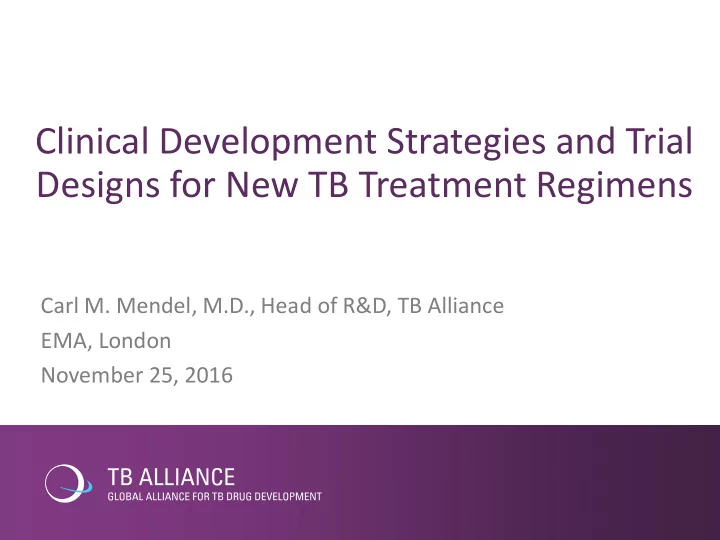

Clinical Development Strategies and Trial Designs for New TB Treatment Regimens Carl M. Mendel, M.D., Head of R&D, TB Alliance EMA, London November 25, 2016
EMA Draft Guidance 2016 • Not prescriptive; flexibility in approach encouraged • Regimen development (multiple drugs developed simultaneously in a regimen) supported – In vitro, animal, and early human data can be used to document individual contributions of drugs in regimen • Indication based on sensitivity to drugs in test regimen – “DS-” and “MDR-TB” categories not relevant to novel treatments – Not necessary to study “DS-” and “MDR” patients in separate trials • Showing superiority of single drug addition to SOC for MDR-TB likely no longer viable – Optimized background therapy based on DST now has 80% success rate in MDR-TB clinical trials – Cf. 85% success rate of HRZE in modern DS-TB clinical trials 2
Additional Background Considerations • No one approach or trial design fits all – Depends on question, rationale, and development strategy – Superior efficacy not the only possible advantage of new drug or regimen Risk : benefit Multiple other highly important advantages possible Proving the exact degree of efficacy may not be of highest importance • Difficult phase 2 to phase 3 transition in TB – Different efficacy endpoints – Wide confidence intervals in phase 2 • Phase 3 endpoint really clinical, supported by bacteriology – Will need small adjustments for liquid medium 3
Regimen Development • Efficacy, safety, risk : benefit – Contribution of each individual drug to efficacy assessed in animal studies and in EBA clinical studies – Safety issues may require deconvolution • Impact: optimal method of use of regimen described at launch – Also efficiency of development pathway • Cf. single drug addition to (MDR) or substitution in (DS) background regimen – Difficult to prove superiority in MDR if “SOC” individualized based on DST – Difficult to prove efficacy in DS: effect on non-inferiority margin – Optimal method of use of drug not always described at launch 4
Unified Development Pathway • DS- and MDR-TB studied together – Primary endpoint is in DS patients Vs HRZE control in randomized comparison – MDR patients not randomized; assessed for similarity of response to same regimen in DS-TB • No MDR-TB control group – Length, difficulty, expense • Optimization of impact 5
STAND - Phase 3 Trial of PaMZ Participants with newly diagnosed smear positive DS- and MDR-TB Pa(100mg)-M-Z N=300 4 months of treatment Pa(200mg)-M-Z 12 & 24 mos N=300 DS f/u after Pa(200mg)-M-Z randomization N= 300 Randomize H-R-Z-E 6 months of treatment N=300 Pa(200mg)-M-Z DR N= up to 300 Pa = pretomanid M = moxifloxacin 400 mg Z = pyrazinamide at 1500mg 6 6
Nix-TB Approach • Skipping phase 2 in highly select population (XDR-TB) – Toxicity of one of the drugs in the regimen restricted the population studied – Unmet medical need of this population allowed skipping of phase 2 • Historical control, small numbers – Advantage not only efficacy – Exact degree of efficacy not the most important aspect of the Nix-TB regimen 7
Nix-TB Pilot Phase 3 Trial in XDR-TB Patients with XDR-TB or Who Have Failed MDR-TB Treatment Follow up for relapse-free cure Pretomanid 200 mg over 24 months Bedaquiline 200 mg 6 months of treatment XDR-TB tiw after 2 week load* Additional 3 months if sputum culture positive at 4 months Linezolid 1200 mg qd** * May adjust dosing based on NC-005 **Just amended from Sites: Sizwe and Brooklyn Chest, South Africa 600 mg bid strategy 8
B-Pa-L Linezolid Optimization Trial: TB Alliance Study NC-007 Patients with XDR-TB, Pre-XDR-TB or who have failed or are intolerant to MDR-TB Treatment 1 o follow up for relapse- free cure 6 months after end of treatment; Full B-L-Pa f/u 24 mos after end of L=1200 mg/d x 6 mos treatment B-L-Pa L=1200 mg/d x 2 mos 6 months of treatment B-L-Pa L=600 mg/d x 6 mos Randomize B-L-Pa L=600 mg/d x 2 mos N=30 per group Pa dose = 200 mg daily; B Dose = 200 mg daily 9
Conclusions • No one approach or trial design fits all – Depends on question, rationale, and development strategy – Superior efficacy (or shorter treatment) not the only possible advantage of new drug or regimen Risk : benefit Multiple other highly important advantages possible Proving the exact degree of efficacy may not be of highest importance • Regimen development and unified development pathway make sense in many situations • Nix-TB approach to regimen development made sense when dealing with a fairly toxic compound (linezolid for long-term use) • Novel approaches will continue to emerge as landscape changes 10
Recommend
More recommend